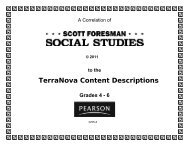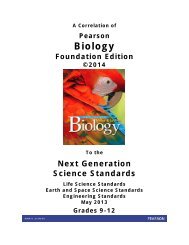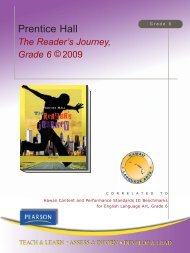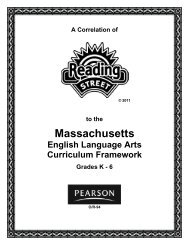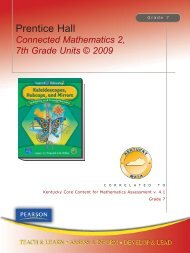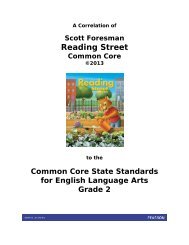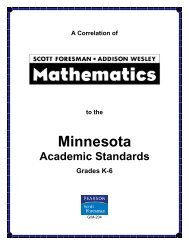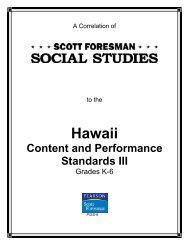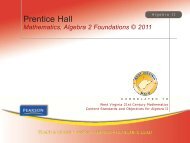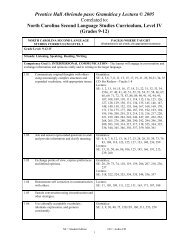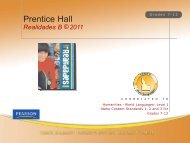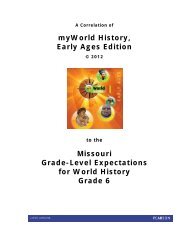Miller & Levine Biology - Pearson
Miller & Levine Biology - Pearson
Miller & Levine Biology - Pearson
Create successful ePaper yourself
Turn your PDF publications into a flip-book with our unique Google optimized e-Paper software.
A Correlation of<strong>Miller</strong> & <strong>Levine</strong> <strong>Biology</strong>, ©2014to the Next Generation Science Standards, May 2013Grades 9-12Science and Engineering PracticesAnalyzing and Interpreting DataAnalyzing data in 9–12 builds on K–8 experiences andprogresses to introducing more detailed statisticalanalysis, the comparison of data sets for consistency, andthe use of models to generate and analyze data.•Analyze data using computational models in order tomake valid and reliable scientific claims. (HS-ESS3-5)SE: Case Study #3 (pp. 177–178)Using Mathematics and Computational ThinkingMathematical and computational thinking in 9-12 builds onK-8 experiences and progresses to using algebraicthinking and analysis, a range of linear and nonlinearfunctions including trigonometric functions, exponentialsand logarithms, and computational tools for statisticalanalysis to analyze, represent, and model data. Simplecomputational simulations are created and used based onmathematical models of basic assumptions.•Create a computational model or simulation of aphenomenon, designed device, process, or system. (HS-ESS3-3)SE: Unit 4 Project (pp. 447a–447b)•Use a computational representation of phenomena ordesign solutions to describe and/or support claims and/orexplanations. (HS-ESS3-6)SE: Use Science Graphics (p. 92); AnalyzingData (p. 164); Case Study #3 (p. 177)Constructing Explanations and Designing SolutionsConstructing explanations and designing solutions in 9–12builds on K–8 experiences and progresses to explanationsand designs that are supported by multiple andindependent student-generated sources of evidenceconsistent with scientific knowledge, principles, andtheories.•Construct an explanation based on valid and reliableevidence obtained from a variety of sources (includingstudents’ own investigations, models, theories,simulations, peer review) and the assumption thattheories and laws that describe the natural world operatetoday as they did in the past and will continue to do so inthe future. (HS-ESS3-1)SE: Chapter 6 mystery (pp. 153 and 183);<strong>Biology</strong> & History (p. 719)•Design or refine a solution to a complex real-worldproblem, based on scientific knowledge, studentgeneratedsources of evidence, prioritized criteria, andtradeoff considerations. (HS-ESS3-4)SE: Quick Lab (p. 155); Unit 6 Project (pp.571a–571b)----------------------------------------------Connections to Nature of ScienceScientific Investigations Use a Variety of Methods•Science investigations use diverse methods and do notalways use the same set of procedures to obtain data.(HS-ESS3-5)Disciplinary Core IdeasESS2.D: Weather and Climate•Current models predict that, although future regionalclimate changes will be complex and varied, averageglobal temperatures will continue to rise. The outcomespredicted by global climate models strongly depend on theamounts of human-generated greenhouse gases added tothe atmosphere each year and by the ways in which thesegases are absorbed by the ocean and biosphere.(secondary to HS-ESS3-6)SE/TE: Greenhouse Gases (p. 164); CaseStudy #3, Climate Change (p. 178)ESS3.A: Natural Resources•Resource availability has guided the development ofhuman society. (HS-ESS3-1)SE/TE: Sustainable Development (pp. 156–157); Soil Resources (pp. 158–160);Freshwater Resources (pp. 160–162);Agriculture (pp. 715–717)ESS3.B: Natural Hazards•Natural hazards and other geologic events haveshaped the course of human history; [they] havesignificantly altered the sizes of human populations andhave driven human migrations. (HS-ESS3-1)ESS3.C: Human Impacts on Earth Systems•The sustainability of human societies and thebiodiversity that supports them requires responsiblemanagement of natural resources. (HS-ESS3-3)SE/TE: Sustainable Development (pp. 156–157); Using Resources Wisely (pp. 158–165);Ecology in Action (pp. 174–179)•Scientists and engineers can make major contributionsby developing technologies that produce less pollution andwaste and that preclude ecosystem degradation. (HS-ESS3-4)SE/TE: Using Resources Wisely (pp. 158–165); Conserving Biodiversity (pp. 170–171);Ecology in Action (pp. 174–179)ESS3.D: Global Climate Change•Though the magnitudes of human impacts are greaterthan they have ever been, so too are human abilities tomodel, predict, and manage current and future impacts.(HS-ESS3-5)SE/TE: Case Study #3, Climate Change (pp.177–179)•Through computer simulations and other studies,important discoveries are still being made about how theocean, the atmosphere, and the biosphere interact andare modified in response to human activities. (HS-ESS3-6)SE/TE: Case Study #1, Atmospheric Ozone(p. 175); Case Study #3, Climate Change(pp. 177–179)Crosscutting ConceptsCause and Effect•Empirical evidence is required to differentiate betweencause and correlation and make claims about specificcauses and effects. (HS-ESS3-1)TE: How Science Works (p. 107); Quick Facts(p. 118); Quick Facts (p. 159); <strong>Biology</strong> inDepth (p. 160)Systems and System Models•When investigating or describing a system, theboundaries and initial conditions of the system need to bedefined and their inputs and outputs analyzed anddescribed using models. (HS-ESS3-6)TE: How Science Works (p. 131)Stability and Change•Change and rates of change can be quantified andmodeled over very short or very long periods of time.Some system changes are irreversible. (HS-ESS3-3),(HS-ESS3-5)SE: Case Study #1 (p. 175); Case Study #3(pp. 177–179)•Feedback (negative or positive) can stabilize ordestabilize a system. (HS-ESS3-4)SE: Chapter 3 Mystery (pp. 63 and 91);Chapter 5 Mystery (pp. 130 and 149)-----------------------------------------------Connections to Engineering, Technology,and Applications of ScienceInfluence of Engineering, Technology, and Scienceon Society and the Natural World•Modern civilization depends on major technologicalsystems. (HS-ESS3-1),(HS-ESS3-3)SE: The Role of Technology (p. 11);Technology & <strong>Biology</strong> (p. 87)TE: How Science Works (p. 112)•Engineers continuously modify these technologicalsystems by applying scientific knowledge and engineeringdesign practices to increase benefits while decreasingcosts and risks. (HS-ESS3-4)TE: <strong>Biology</strong> in Depth (p. 162)•New technologies can have deep impacts on societyand the environment, including some that were notanticipated. (HS-ESS3-3)TE: <strong>Biology</strong> in Depth (p. 97); BuildingScientific Literacy, STEM (p. 152a); BuildingScientific Literacy, STEM (p. 153)SE = Student Edition; TE = Teacher’s Edition; LMA = Lab Manual A 22



